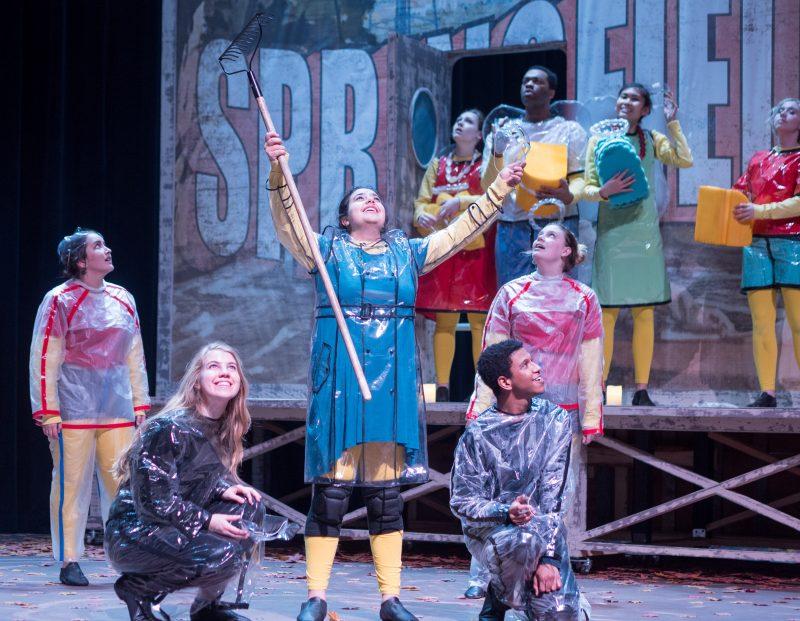For the first two acts of “Mr. Burns: A Post-Electric Play,” leaves cover the floor of the Stieren Theatre’s stage. The clearing of the leaves at the start of act three signifies to the audience that the play is about to change. The apocalyptic fog covering the first two acts has lifted in the fictional 75-year time jump between act two and act three, revealing the mythologized donut from both “The Simpsons” and Trinity Theatre’s marketing campaign. From an audience perspective, however, much of that fog seemed to remain, in both the plot and the themes of “Mr. Burns.”
The production opened last Friday, Feb. 16, and contains three acts separated by two 10-minute intermissions. As audience members seat themselves, they notice that the curtains are open, revealing the cast members silently acting around a staged campfire.
Since act one begins in the middle of this long, fireside conversation in the woods, the open curtain helped make this beginning feel less theatrical and more natural. Together the actors recall the “Cape Feare” episode of “The Simpsons” — while believable in its subject mater, this was comically ridiculous in its specificity.
The time it takes for the characters to go through the plot extends past the episode’s runtime, as the characters try to nail down exact lines of dialogue and go on tangents about its cultural references. The wordiness and sheer amount of dialogue was impressive, as the first act hinges on the delivery of this conversation.
“I think that being an ensemble and listening to each other is very helpful with dialogue. Instead of looking at it like line-to-line, it’s response-to-response,” said Mindy Tran, junior theatre major who played the roles of Jenny and Marge Simpson. “I think that in the first act, my character was very nervous about everything that was happening. We were trying to keep our minds off the reality that nuclear power plants are near, and Jenny is very particular in her memorization. She wants to get the details exactly right.”
Though act one follows a group of people bound together by a mysterious disaster that has split them from their family and friends, the plot doesn’t have much to do with how or why this group comes together. Each act break serves as a time jump in the play’s plot, but they also signify a shift in tone between each of the acts.
The anxiety of act one is still present in act two, but the first act’s post-apocalyptic fear is replaced by the logistics of running a theatre troupe. Seven years after the first act, the characters have developed a traveling acting group that recreates the experience of watching television, performing shows related to “The Simpsons” as well as live commercials.
“We talked about how theater is the most prominent job prospect,” Tran said, referencing the post-apocalyptic job market. “In act two, those commercial scenes and chart-hits our characters performed had to be looked at very seriously, because the better we performed, the more money we made. I remember our director Rachel telling us that even if we felt our character was really uncomfortable, we knew that they had to do it.”
While the threats in act one are still very present, the majority of act two stifles them with performance, showing the characters have developed a full-time way to distract themselves with “The Simpsons.”
Without spoiling anything, the end of act two and transition into act three reveals that “Mr. Burns” is a play less concerned with the apocalypse than it is about the role of theatre. It’s interesting to note that the mysterious power plant meltdown doesn’t really set the plot into motion. Instead, it was the arrival of Gibson, the first of Nico Champion’s three roles, who was a part of a theatre troupe before the disaster struck.
In many ways, “Mr. Burns” pens a convincing, albeit confusing, love letter to the cultural power of theatre. By act three, theatre has managed to mythologize “The Simpsons,” as well as artists like Lady Gaga, Eminem and Britney Spears, for a new generation of post-apocalyptic viewers.
For the pre-apocalyptic viewer, however, “Mr. Burns” leaves a lot for the viewer to consider, not least of which is how the audience should process the trauma of the first two acts without closure from the performative ww
“Mr. Burns: A Post-Electric Play” will continue to be performed in the Stieren Theatre on Feb. 23 and 24 from 8–10 p.m.







